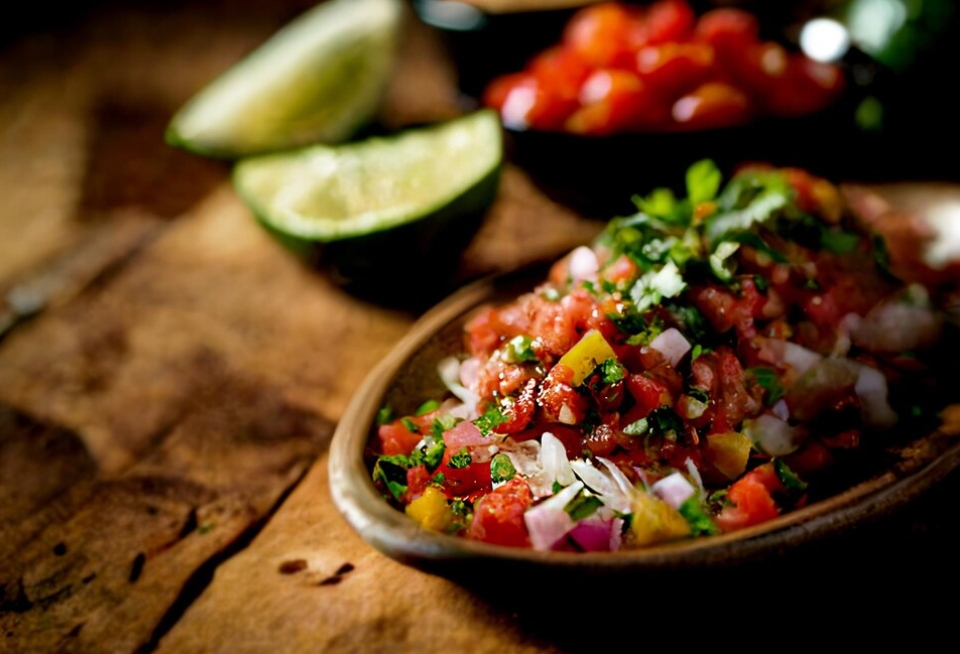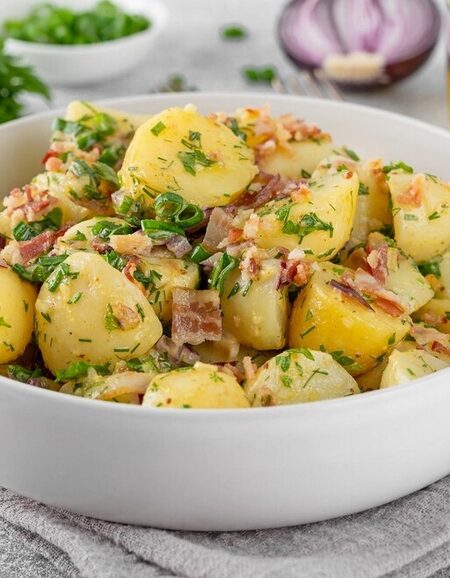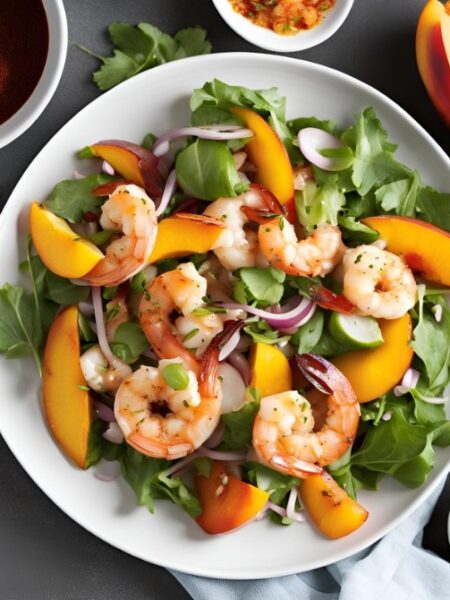Pico de Gallo Recipe
Pico de Gallo: The Fresh Heart of Mexican Cuisine. When it comes to fresh, vibrant, and flavorful salsas, few can rival the simple yet delicious Pico de Gallo. This classic Mexican condiment, also known as salsa fresca or salsa cruda, embodies the essence of Mexican cooking — bright, fresh ingredients coming together in perfect harmony. More than just a salsa, Pico de Gallo is a culinary icon that enhances countless dishes with its refreshing zest and rustic charm. Whether you’re a seasoned home cook or just beginning to explore Mexican flavors, Pico de Gallo is a must-have recipe in your kitchen repertoire.
A Historical and Cultural Staple- Pico de Gallo
Pico de Gallo’s origins trace back to traditional Mexican cuisine, where fresh, local ingredients have always been the cornerstone. Unlike cooked salsas, Pico de Gallo is uncooked, relying solely on the natural freshness and quality of its components. The name “Pico de Gallo,” which translates to “rooster’s beak,” is believed to refer either to the way it was originally eaten — pinched between the thumb and forefinger resembling a beak — or to the salsa’s sharp, bright flavors reminiscent of a rooster’s call.
Throughout Mexican history, fresh salsas like Pico de Gallo were essential accompaniments to staple foods such as tortillas, beans, and grilled meats. They added moisture, flavor, and nutritional variety to meals. In modern times, Pico de Gallo has crossed borders, embraced worldwide for its simplicity, healthfulness, and ability to complement a wide array of dishes.
Simplicity That Showcases Freshness
What makes Pico de Gallo so special is its simplicity. With just a handful of fresh ingredients — ripe tomatoes, onions, jalapeños, cilantro, lime juice, and salt — this salsa is all about celebrating the natural flavors of each component. There are no complicated steps or hard-to-find ingredients, making it accessible to cooks of all skill levels.
The tomatoes provide a juicy sweetness and a subtle acidity, while the white onion contributes crunch and a sharp bite. Jalapeños bring a mild to moderate heat that awakens the palate without overwhelming it, and fresh cilantro adds a herbal brightness that ties everything together. The lime juice adds tanginess and brightness, lifting the flavors to a refreshing peak. Salt acts as the seasoning enhancer, making each ingredient’s natural flavor shine.
Because the ingredients are raw, the quality and freshness matter immensely. Using ripe, juicy tomatoes and fresh herbs makes all the difference, creating a salsa that is lively, crisp, and full of natural flavor — a perfect counterpoint to richer or spicier dishes.
Versatility in Every Bite- Pico de Gallo
Pico de Gallo is incredibly versatile and transcends its role as a mere salsa. It can be used as a dip with tortilla chips, a topping for tacos, burritos, grilled meats, fish, and eggs, or even as a light salad on its own. Its bright flavors and crunchy texture provide contrast to heavier, richer dishes, making meals feel more balanced and fresh.
For example, a spoonful of Pico de Gallo on a grilled steak cuts through the richness of the meat with acidity and brightness. On tacos, it adds crunch and freshness, elevating each bite. Even simple dishes like scrambled eggs or roasted vegetables benefit from its lively touch. In addition, it’s a fantastic addition to Mexican-style bowls or wraps, giving a fresh, homemade element that can’t be replicated by bottled salsas.
Beyond traditional Mexican dishes, Pico de Gallo can be creatively incorporated into other cuisines. It pairs well with grilled seafood in Mediterranean-inspired meals or can be used as a fresh salsa topping for burgers and sandwiches. Its adaptability makes it a go-to condiment in many kitchens worldwide.
Health Benefits of Pico de Gallo
In an age when health-conscious eating is increasingly important, Pico de Gallo stands out as a nutrient-packed, low-calorie option. The fresh vegetables provide an excellent source of vitamins, antioxidants, and dietary fiber. Tomatoes, rich in vitamin C and lycopene, are known for their antioxidant properties that promote heart health and reduce inflammation.
Onions contribute immune-supporting compounds and add a dose of prebiotic fiber beneficial for gut health. Jalapeños contain capsaicin, which has been linked to metabolism boosting and pain relief. Cilantro offers detoxifying properties and vitamins A and K, while lime juice adds a healthy dose of vitamin C and aids in digestion.
Because Pico de Gallo is made from raw, fresh ingredients with no added sugars or preservatives, it fits perfectly into clean eating, vegan, vegetarian, paleo, and gluten-free diets. It’s a flavorful way to increase vegetable intake without adding unnecessary calories or unhealthy fats.
A Fresh Alternative to Cooked Salsas- Pico de Gallo
While many salsas are cooked and simmered to develop deep, smoky flavors, Pico de Gallo’s uncooked, fresh nature makes it unique. This means it has a brighter, more immediate flavor that bursts with the freshness of each ingredient. It also requires no cooking, making it quick to prepare and perfect for warm weather or when you want a no-fuss accompaniment.
Because of its raw character, Pico de Gallo complements cooked dishes by providing contrast in texture and flavor. This interplay between the hot, often spicy cooked food and the cool, crisp salsa is a hallmark of Mexican culinary balance.
Customization and Regional Variations
While the classic Pico de Gallo recipe remains consistent in its core ingredients, there are numerous regional and personal variations that reflect local tastes and available produce. Some recipes add diced avocado for creaminess, others include diced mango or pineapple for a sweet twist. Some cooks use serrano peppers instead of jalapeños for a sharper heat, or add garlic for a bit more pungency.
Additionally, the ratio of ingredients can be adjusted. Some prefer a tomato-heavy salsa, while others emphasize the onion or peppers for extra bite. These variations show Pico de Gallo’s flexibility and its role as a customizable base recipe, inviting cooks to make it their own.
Why Every Kitchen Needs Pico de Gallo
Given its simplicity, freshness, and versatility, Pico de Gallo is a must-have staple in any kitchen. It requires minimal ingredients, no cooking, and can transform ordinary meals into something special with little effort. It encourages the use of fresh produce and brings a taste of Mexican culinary tradition into your home.
Whether you’re serving a festive Mexican dinner or simply want a fresh topping for grilled chicken or fish, Pico de Gallo offers a burst of flavor and texture that enhances any meal. It’s easy to prepare, healthy, and endlessly adaptable — a true culinary gem.
Pico de Gallo – More Than Just a Salsa
Pico de Gallo is much more than a simple salsa; it’s a celebration of fresh, wholesome ingredients and the rich cultural heritage of Mexican cuisine. Its balance of acidity, heat, and freshness makes it a timeless favorite that complements countless dishes. Its health benefits and ease of preparation have helped it gain international popularity far beyond Mexico’s borders.
As you explore Mexican cooking or seek ways to brighten your meals with fresh, natural flavors, Pico de Gallo stands out as a perfect starting point. With every bite, you taste tradition, freshness, and the vibrant spirit of Mexican food culture — all in a humble, colorful bowl.
Pico de Gallo Recipe
Ingredients:
- 4 medium ripe tomatoes, finely diced
- 1 small white onion, finely chopped
- 1-2 jalapeño peppers, seeded and finely chopped (adjust heat to taste)
- 1/2 cup fresh cilantro, chopped
- Juice of 1 lime
- Salt to taste
Instructions:
- Combine the diced tomatoes, onion, jalapeño, and cilantro in a bowl.
- Squeeze fresh lime juice over the mixture.
- Add salt to taste and stir gently to combine.
- Let it sit for about 10-15 minutes to allow flavors to meld before serving.
Total Time Breakdown:
Prep Time: 10 minutes
Resting Time: 10-15 minutes
Total Time: 20-25 minutes
Servings:
4-6 servings
Essential cooking tips to perfect your Pico de Gallo
1. Choose Ripe, Firm Tomatoes
The quality of your tomatoes can make or break your Pico de Gallo. Opt for ripe but firm tomatoes, such as Roma or vine-ripened varieties, which offer a balance of sweetness and acidity without being overly watery. Tomatoes that are too soft or overripe will release excess juice, making your salsa watery and diluting the flavors. Before dicing, remove the seeds and excess juice to keep your salsa chunky and vibrant. This ensures a fresh, crisp texture and helps the other ingredients shine.
2. Use Fresh, Crisp Onions
White onions are traditional in Pico de Gallo because of their sharp but clean flavor, but freshness is key. Choose onions that are firm and free from any sprouting or soft spots. Finely chop the onions to distribute their pungency evenly, but don’t overdo it—too large pieces can overpower the salsa. For a milder onion flavor, soak the chopped onions briefly in cold water and drain well before mixing. This technique tones down their bite while maintaining crunch.
3. Control the Heat Level with Jalapeños
Jalapeños add the essential kick that defines Pico de Gallo’s flavor profile, but controlling their heat level is important. To reduce spiciness, remove the seeds and white membranes inside the peppers, where most of the capsaicin is concentrated. If you prefer more heat, keep some or all of the seeds. Always handle jalapeños with care—wear gloves or wash your hands thoroughly after cutting to avoid irritation. Adjust the amount and type of chili pepper to suit your taste, making the salsa either mild or fiery.
4. Use Fresh Lime Juice and Season Gradually
Freshly squeezed lime juice is a game-changer for Pico de Gallo, adding bright acidity that lifts all the flavors. Avoid bottled lime juice, which can taste artificial and dull the freshness. When seasoning with salt, add it gradually and taste as you go—salt helps bring out the natural sweetness of the tomatoes and balances the acidity but too much can overwhelm the salsa. The lime and salt also help mellow the raw onion’s sharpness, so balancing these ingredients carefully is essential for a harmonious flavor.
5. Let the Salsa Rest Before Serving
While it might be tempting to dig in right after mixing, letting Pico de Gallo rest for at least 10 to 15 minutes before serving allows the flavors to meld together beautifully. This resting period gives the lime juice and salt time to slightly soften the onions and jalapeños, reducing their harshness, while allowing the herbs and tomatoes to infuse the salsa with their combined freshness. For best results, store it in the refrigerator during this resting time, which also keeps the salsa crisp and refreshing.
FAQs about Pico de Gallo Recipe
1. What is Pico de Gallo?
Pico de Gallo is a traditional Mexican fresh salsa made from chopped tomatoes, onions, jalapeños, cilantro, lime juice, and salt. Unlike cooked salsas, it’s raw and chunky, offering a bright, fresh flavor with a crisp texture. The name means “rooster’s beak” in Spanish, possibly referring to how it was originally eaten by pinching the salsa between the fingers or the sharp, zesty flavors it delivers.
2. How long does Pico de Gallo last?
Because Pico de Gallo is made from fresh, uncooked ingredients, it’s best enjoyed within 2 to 3 days of preparation when stored in an airtight container in the refrigerator. Over time, the tomatoes release more juice, and the salsa can become watery and lose some of its crispness. For the freshest flavor, consume it within the first day or two.
3. Can I make Pico de Gallo less spicy?
Absolutely! To reduce the heat, simply remove the seeds and membranes from the jalapeños, which contain most of the spiciness. You can also use milder peppers like poblano or even omit the peppers altogether for a completely mild version. Adjusting the heat level is easy and lets you tailor the salsa to your personal preference or audience.
4. Is Pico de Gallo gluten-free and vegan?
Yes, Pico de Gallo is naturally gluten-free and vegan, as it contains only fresh vegetables, herbs, lime juice, and salt. It’s a great condiment for people with gluten sensitivities, celiac disease, or those following vegan and vegetarian diets. Just make sure no cross-contamination occurs during preparation.
5. Can I prepare Pico de Gallo in advance?
You can prepare Pico de Gallo a few hours ahead of time to allow the flavors to meld, but it’s best to avoid making it too far in advance. The fresh ingredients, especially the tomatoes and onions, will start to release water and soften, which changes the texture. If you need to prepare it earlier, store it tightly covered in the fridge and drain any excess liquid before serving.
6. What can I use Pico de Gallo for?
Pico de Gallo is incredibly versatile. Use it as a dip for tortilla chips, a topping for tacos, burritos, grilled meats, fish, eggs, or as a fresh salad on its own. It also pairs well with grilled vegetables, rice bowls, or even as a topping on burgers and sandwiches to add a fresh, zesty kick.
7. Can I substitute other peppers for jalapeños?
Yes, you can substitute jalapeños with other chili peppers depending on your heat preference. Serrano peppers are a common alternative if you want more heat, while milder peppers like Anaheim or poblano are good for a gentler spice. Remember to adjust the amount and always remove seeds to control the heat level.
8. Why does my Pico de Gallo get watery?
Pico de Gallo can become watery if the tomatoes are too juicy or overripe, or if it’s stored for too long. To prevent this, use firm, ripe tomatoes and remove seeds and excess juice before chopping. Also, drain any liquid that accumulates before serving. This helps keep the salsa chunky and flavorful.
9. Can I freeze Pico de Gallo?
Freezing Pico de Gallo is generally not recommended because the fresh vegetables, especially tomatoes and onions, lose their texture and become mushy after thawing. The flavors also become less vibrant. It’s best to enjoy Pico de Gallo fresh or refrigerated for a few days rather than frozen.
10. What’s the best way to store Pico de Gallo?
Store Pico de Gallo in an airtight container in the refrigerator to maintain its freshness and crispness. Covering it tightly prevents the salsa from absorbing other fridge odors and helps slow down spoilage. Stir the salsa gently before serving if any liquid has separated at the bottom.
Pico de Gallo Recipe
Pico de Gallo is much more than a simple salsa; it’s a celebration of fresh, wholesome ingredients and the rich cultural heritage of Mexican cuisine. Its balance of acidity, heat, and freshness makes it a timeless favorite that complements countless dishes. Its health benefits and ease of preparation have helped it gain international popularity far beyond Mexico’s borders.
As you explore Mexican cooking or seek ways to brighten your meals with fresh, natural flavors, Pico de Gallo stands out as a perfect starting point. With every bite, you taste tradition, freshness, and the vibrant spirit of Mexican food culture — all in a humble, colorful bowl.

Ingredients
Instructions
- • Combine the diced tomatoes, onion, jalapeño, and cilantro in a bowl.
- • Squeeze fresh lime juice over the mixture.
- • Add salt to taste and stir gently to combine.
- • Let it sit for about 10-15 minutes to allow flavors to meld before serving.





